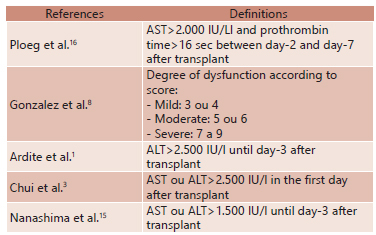ABSTRACT
Background:
The outcome of the patients after liver transplant is complex and to characterize the risk for complications is not always easy. In this context, the hepatic post-reperfusion biopsy is capable of portraying alterations of prognostic importance.
Aim:
To compare the results of liver transplantation, correlating the different histologic features of the hepatic post-reperfusion biopsy with graft dysfunction, primary non-function and patient survival in the first year after transplantation.
Method:
From the 377 transplants performed from 1996 to 2008, 164 patients were selected. Medical records were reviewed and the following clinical outcomes were registered: mortality in 1, 3, 6 and 12 months, graft dysfunction in varied degrees and primary graft non-function. The post-reperfusion biopsies had been examined by a blinded pathologist for the outcomes. The following histological variables had been evaluated: ischemic alterations, congestion, steatosis, neutrophilic exudate, monomorphonuclear infiltrate and necrosis.
Results:
The variables associated with increased mortality were: steatosis (p=0.02209), monomorphonuclear infiltrate (p=0.03935) and necrosis (p<0.00001). The neutrophilic exudate reduced mortality in this study (p=0.00659). The primary non-function showed significant association (p<0.05) with the necrosis, steatosis and the monomorphonuclear infiltrate.
Conclusion:
Post-reperfusion biopsy is useful tool to foresee complications after liver transplant.
HEADINGS:
Hepatic Biopsy; Reperfusion; Liver Transplant; .Primary Graft Dysfunction; Complications; Survival


